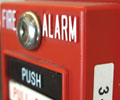

Offering fire detection and alarm systems is an attractive option for electrical contractors looking to grow or diversify their business. It is, however, a very price sensitive market, so to carry out this type of work successfully and profitably, it is important to choose a fire protection system that combines reliability and versatility with economy. Alan Locke of Fike Safety Technology provides some useful guidelines.
A common assumption among specifiers and even some contractors is that fire protection systems are divided into two major groups – conventional and addressable. With conventional systems, a simple control panel is used and the fire detectors are connected to this via one or more circuits, depending on the size and complexity of the installation. Separate circuits are used to connect the sounders and beacons to the control panel.
Conventional systems are usually assumed to be the most suitable and most cost effective option for small- to medium-sized applications, such as small apartment blocks and houses of multiple occupation. This assumption is often incorrect, however, as we shall see shortly.
Addressable systems are considerably more complex. They use detectors that send digital data over the circuit to the control panel, which means that they can provide detailed information about the location of the fire. This is a crucial benefit in a large installation like in an office block or a major retail site, but much less important in small installations where the site of the fire will either be readily apparent or easy to locate. Generally speaking, addressable systems are an unnecessarily complex and expensive choice for smaller installations.
It would seem therefore, that for a small- and medium-sized installations, conventional systems are the way to go. However, there is a third option, which is all too often overlooked. This is the two-wire or bi-wire system.
The components for two-wire fire alarm systems cost only a little more than those for conventional systems, and there are big savings to be made on installation costs. Two-wire systems use simple inexpensive cabling and the detectors, manual call points, sounders and beacons all share the same cable.
The result is that the overall cost of a two wire installation is almost invariably lower than that of a conventional system for the same application. Additionally, depending on the equipment chosen, the two wire system is likely to offer valuable increased functionality. For specifiers, installers and end users alike, therefore, two wire systems are a very attractive option.
But what can be expected of a two wire system? First of all, control panels are typically available with two, four or eight zones. A four-zone panel is a good choice, for example, in an apartment block with three apartments, since each apartment can have its own zone, while the fourth zone is allocated to the hallways, staircases and other common areas. Clearly, an eight zone panel would be used for a similar property with up to seven apartments.
While it won’t show which individual detector has been operated, this arrangement will show in which apartment the actuation has taken place and, in some systems, it will also show whether the actuation originates from an automatic detector or a manual call point. Advanced two wire systems can go even further by offering the option to respond differently to signals from alarm devices based on their type and location.
For example, in our apartment block, consider the benefits of the following set-up option; a fire signal from a manual call point or automatic detector in a common area can be arranged to instantly trigger sounders and beacons throughout the entire premises, whereas a fire signal from an automatic detector on one of the apartments can be arranged to initially trigger the sounders and beacons in that apartment only. If, however, the fire signal from the apartment persists for, say, one minute, the alarm is raised throughout the premises.
This arrangement is useful as a fire signal from a single apartment may well mean nothing more than someone has burnt their toast, in which case raising a general alarm is unnecessary and disruptive. This complies fully with Part 1 and Part 6 of British Standard BS5839.
It is also worth noting that the detectors used in two wire systems are by no means all the same. The most useful are types with both smoke and heat sensors. In most instances, a combination of heat and smoke detection will give the optimum balance between fast response to a real fire and freedom from false alarms. However, there are locations where it is preferable to reduce the influence or even disable one or other of the detection functions, and good detectors will allow the installer to do this.
Hopefully this short article has shown that, in all but the very simplest and most complex of fire protection installations, the two wire option offers the best value for money. These types of systems make it easier for contractors to win more contracts and improve profits, while at the same time gaining satisfied customers.
For more information contact Geoff Clarke, Okavango Electronics, +267 391 2626, sales@okavelectron.com, www.okavelectron.com

© Technews Publishing (Pty) Ltd. | All Rights Reserved.